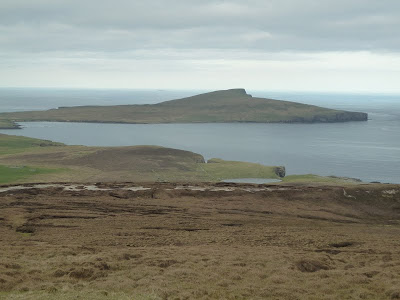 |
| An Sgarsoch from Carn Ealar |
 |
| An Sgarsoch summit |
 |
| Carn Ealar from An Sgarsoch |
 |
| Monadh Mor and Beinn Bhrotain |
 |
| Another shower, another rainbow |
 |
| Linn of Dee and more showers |
Geldie Munros, Saturday, 28 May 2011
Distance: 40 kilometres,
Ascent: 1050 metres,
Time: 9 hours 48 minutes
Carn Ealar 994metres 4hrs 50mins
An Sgarsoch 1006metres 6hrs 7mins
I had agreed earlier in the week to have a long walk with Mark but the mountain weather information service mwis was predicting strong winds, heavy showers and freezing temperatures at Munro height. The original intention to head to Glencoe was axed late on Friday and as I began to think of alternatives I remembered that the Geldie Lodge Munros were still on the to-do list. They are some of the most remote Munros, although less difficult to reach than Luirg Mor, Fisherfield or Knoydart.
They involve a long walk in from the Linn of Dee but there would be minimum time on the tops in the strong winds. I had climbed these hills twice before from Linn of Dee, once in December, but only on walking to Geldie Lodge did I remember that I had cycled in on both previous occasions. Cycling in took about an hour on the gravelly tracks and slightly less time on the descent compared to a two-and-a-half-hour walk that would have to be repeated at the end of the day. But any Munro round requires days like this and the hills themselves are nothing special as the photographs confirm.
The real attractions on days like today are to escape the daily routine, start early, exercise hard, enjoy conversation, the wildlife, crazy weather and to have an adventure with no limits. Linn of Dee is a favourite haunt for starting big walks into the Cairngorms and the car park was full on a bank holiday weekend despite the frequent showers, high winds and forecast of more of the same. The track to White Bridge and then along the Geldie Burn is long and we had to wade knee-deep across one of the burns. The ford at Geldie Lodge was a torrential patch of water and we headed upriver to find a less aggressive reach of water. We managed across without mishap and retreated to a sheep shelter to escape the rain, wring out socks, empty our boots and eat some lunch before starting out on the very well-made footpath westwards towards Carn Ealar.
The showers were passing through quickly and in between the light conditions were good. The ascent up the northeast flank of Carn Ealer was over boggy ground with heather slowing progress but we were in the lee of the hill and only in the last kilometre were we exposed to the wind. A few ptarmigans were croaking and circling me as I passed their nest sites. After a quick stop for some food and drink at the summit we realised that we would not be down until after 7pm, we had already been walking for almost 5 hours.
There is an easy descent to the southeast for a couple of kilometres before dropping steeply to the bealach and then just a long steady climb to An Sgarsoch. It seemed relentless as it had on the previous 4 visits, two in each direction, and we reached the summit to find another three walkers who had opted for a similar long day, although one had wisely cycled up to the lodge. We descended the long heather slopes and followed the boggy course of a burn back to Geldie Lodge, a substantial ruin in a remote location.
After a last stop for water, it was time to wade the rivers and begin the long slog back. We were treated to more showers and some spectacular rainbows before we reached Linn of Dee. We were tired from the exertions but pleased to have completed these challenging hills in inclement conditions. They are a benchmark against which the good days can be truly appreciated. We read the notice warning us about the risk of the river crossings and danger on the hills and realised that taking risks is one of the reasons why we continue on days like today.

























